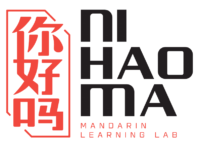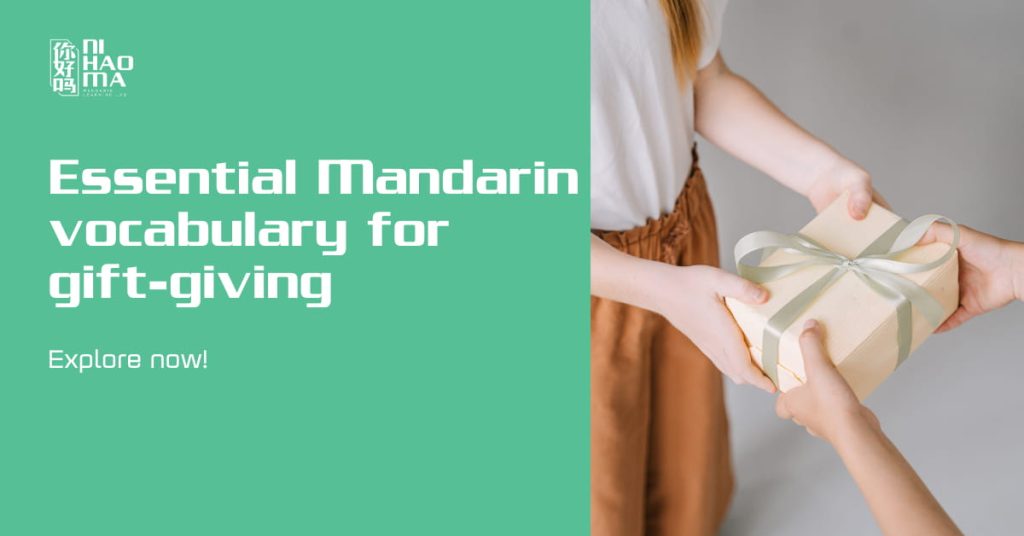Objects in Mandarin are an essential grammatical component, especially when it comes to constructing sentences and expressing ideas in daily conversations. Understanding objects thoroughly not only helps you communicate more clearly in Mandarin, but also prevents many common grammar mistakes. So, where do objects appear in a sentence, and what key points should learners keep in mind?
What Are Objects in Mandarin?
In Mandarin, an object (宾语 – bīnyǔ) refers to the element in a sentence that receives the action of the verb.
In other words, the object answers the question: Who? What? Which entity? — it is the person or thing affected by the action described in the sentence. Objects play a crucial role in Mandarin sentence structure, providing additional information and clarifying who or what the action is directed toward.
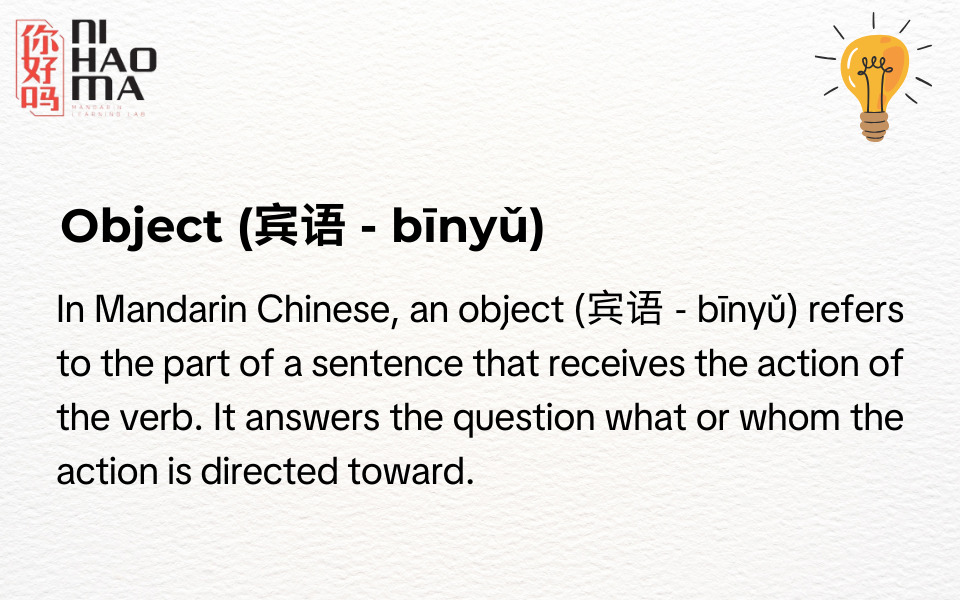
Examples:
我喜欢这本书。
(Wǒ xǐhuān zhè běn shū.)
I like this book.
→ “这本书” (this book) is the object, affected by the verb “喜欢” (like).
她学中文。
(Tā xué zhōngwén.)
She studies Chinese.
→ “中文” (Chinese) is the object, affected by the verb “学” (study).
Types of Objects in Mandarin
Objects in Mandarin are not just simple nouns following verbs. They come in several forms, each with its own characteristics. Let’s look at the different types of objects you’ll encounter when learning Mandarin grammar.
1. Simple Objects
A single object is the simplest type of object in Mandarin, consisting of only a single word, such as a noun or a pronoun. This is the most common type of object in Mandarin sentences, often found in short, straightforward sentences. Single objects are typically nouns referring to things, events, or people.
Examples:
我喜欢你。
(Wǒ xǐhuān nǐ.)
I like you.
→ “你” is the object.
他买水果。
(Tā mǎi shuǐguǒ.)
He buys fruit.
→ “水果” is the object.
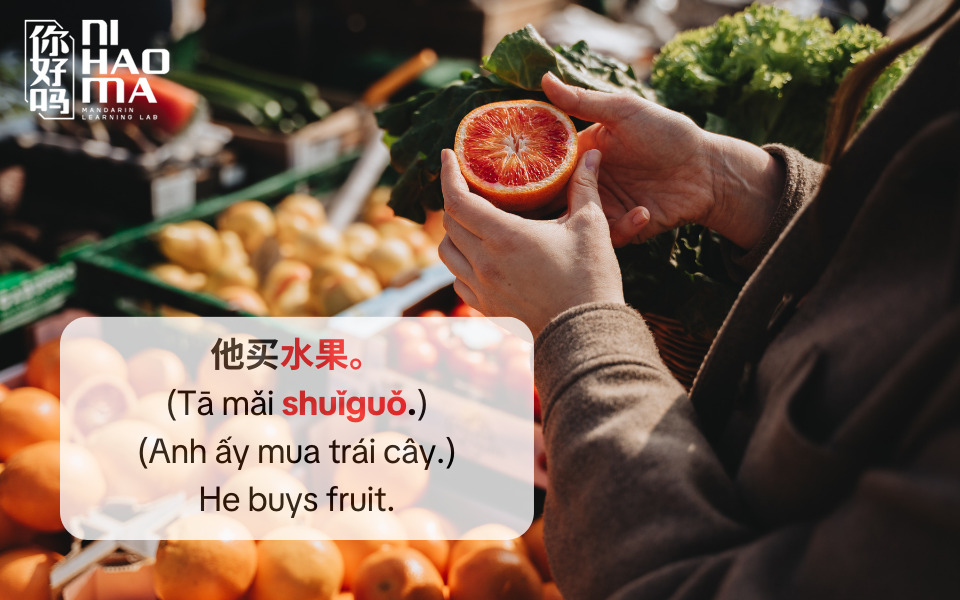
2. Clausal Objects
A clausal object is a more complex object, represented by an entire noun clause describing a situation or action.
Examples:
她喜欢你送给她的礼物。
(Tā xǐhuān nǐ sòng gěi tā de lǐwù.)
She likes the gift you gave her.
→ The object here is the clause “你送给她的礼物” (nǐ sòng gěi tā de lǐwù).
我知道他去了哪里。
(Wǒ zhīdào tā qùle nǎlǐ.)
I know where he went.
→ The entire clause “他去了哪里” (tā qùle nǎlǐ) functions as the object.
3. Complex Objects (Noun Phrases)
A complex object is an object expanded by modifiers such as attributives, quantifiers, adjectives, or relative clauses. Complex objects provide more detailed descriptions of the affected entity. They often follow this structure:
Attributive + (Quantifier) + Main Noun
Example:
我喜欢漂亮的衣服。
(Wǒ xǐhuān piàoliang de yīfu.)
I like beautiful clothes.
→ The object is the noun phrase “漂亮的衣服” (piàoliang de yīfu).
我喜欢你送给我的礼物。
(Wǒ xǐhuān nǐ sòng gěi wǒ de lǐwù.)
I like the gift you gave me.
→ The object is the noun phrase “你送给我的礼物” (nǐ sòng gěi wǒ de lǐwù).
Read more: What Are Chinese Attributives Modifiers?
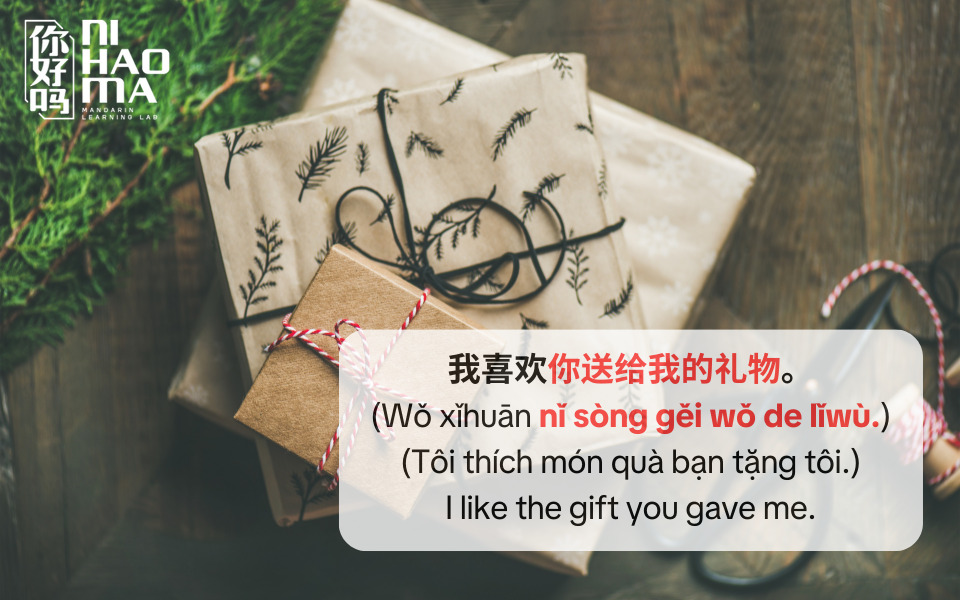
4. Double Objects
Double objects form a special grammatical structure in Mandarin, where a verb takes two objects: indirect and direct objects. The direct object is the entity directly affected by the action, while the indirect object is the recipient of the action.
The sentence structure for double objects is:
Subject + Verb + Indirect Object + Direct Object
Examples:
我送给他一本书。
(Wǒ sòng gěi tā yì běn shū.)
I gave him a book.
In this sentence:
- “一本书” (yì běn shū) is the direct object.
- “他” (tā) is the indirect object.
Sentence Structures with Objects in Mandarin
Objects in Mandarin play a crucial role in Chinese sentence structure, as they provide essential information about the recipient or target of an action. Depending on the type of verb used, a sentence in Mandarin can contain either one or two objects.
Sentence Structure with One Object
This is the simplest type of sentence, where the verb acts on a single object, which can be a noun, a pronoun, or a noun phrase. In sentences with only one object, the object follows the verb directly, without the need for any linking element. The basic structure is:
Subject + Verb + Object
Examples:
我喜欢汉语。
(Wǒ xǐhuān hànyǔ.)
→ I like Chinese.
他看书。
(Tā kàn shū.)
→ He reads a book.
她喝咖啡。
(Tā hē kāfēi.)
→ She drinks coffee.
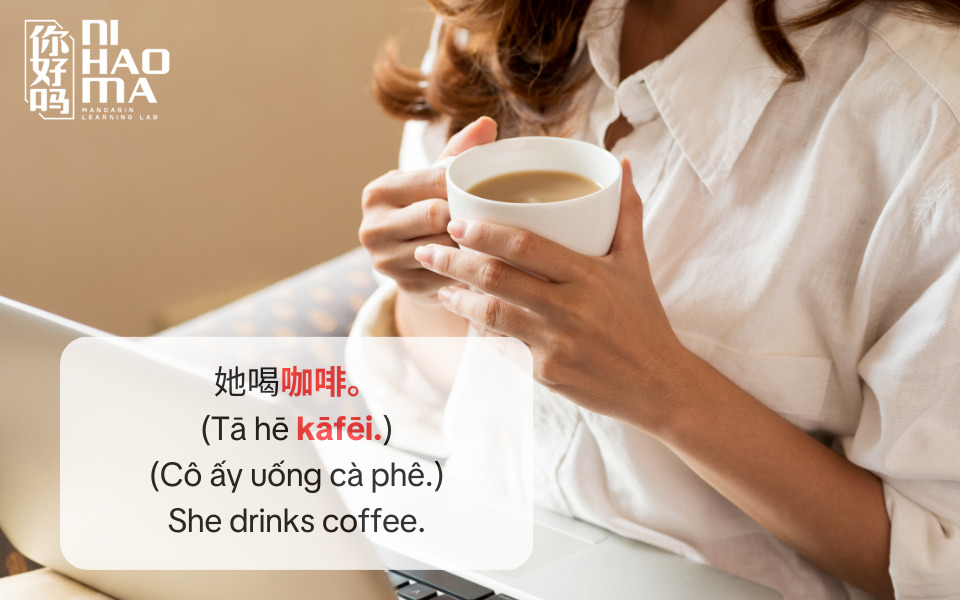
Sentence Structure with Two Objects
Some sentences in Mandarin contain two objects, meaning the verb acts upon two targets at once. These objects have different roles and positions in the sentence:
- The first object (indirect object) usually refers to the recipient of the action.
- The second object (direct object) refers to the item being transferred, given, taught, or otherwise affected by the action.
The basic formula for this structure is:
Subject + Verb + Object 1 + Object 2
Examples:
我送你一份礼物。
(Wǒ sòng nǐ yī fèn lǐwù.)
→ I give you a gift.
老师教我们汉语。
(Lǎoshī jiāo wǒmen hànyǔ.)
→ The teacher teaches us Chinese.
Verbs That Take Two Objects
In objects in Mandarin, certain verbs are particularly associated with double-object constructions. These verbs generally convey some form of transfer or communication — meaning they require both a recipient (indirect object) and an item (direct object). Some of the most common verbs in this group include:
| Verb | Pinyin | Meaning |
|---|---|---|
| 给 | gěi | to give |
| 送 | sòng | to give, to send |
| 问 | wèn | to ask |
| 告诉 | gàosù | to tell |
| 借 | jiè | to lend, to borrow |
| 教 | jiāo | to teach |
| 买 | mǎi | to buy (for someone) |
| 还 | huán | to return (something to someone) |
| 留 | liú | to leave (something for someone) |
Illustrative Examples:
我给你一本书。
(Wǒ gěi nǐ yī běn shū.)
→ I give you a book.
Object 1: 你 (you)
Object 2: 一本书 (a book)
老师教我们汉语。
(Lǎoshī jiāo wǒmen hànyǔ.)
→ The teacher teaches us Chinese.
Object 1: 我们 (us)
Object 2: 汉语 (Chinese)
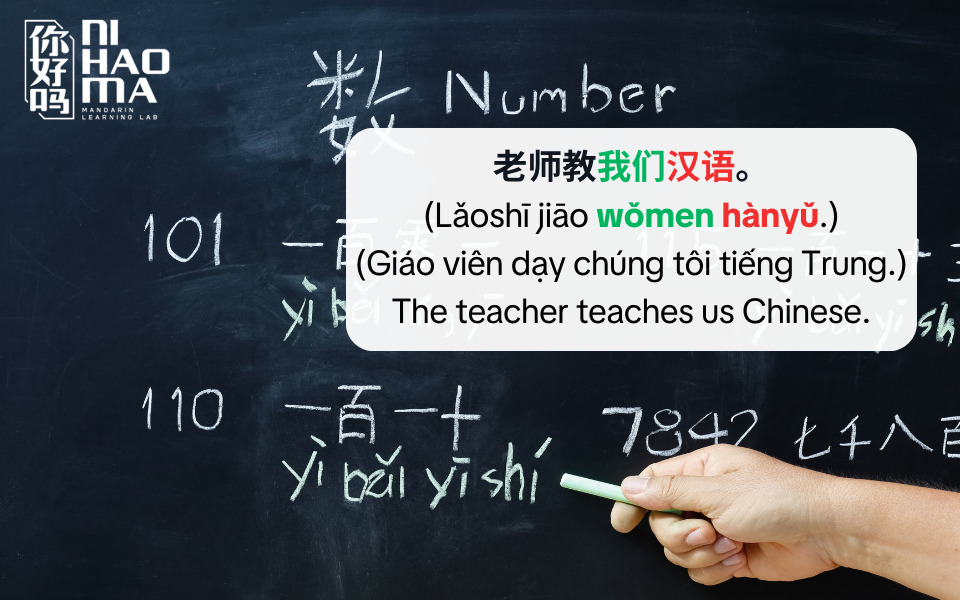
The Difference Between Objects and Complements in Mandarin
When learning Mandarin, many learners tend to confuse objects in Mandarin (宾语 – bīnyǔ) and complements (补语 – bǔyǔ). Both elements appear after the verb, but they serve entirely different grammatical functions.
Grammatical Nature
An object refers to the entity that directly receives the action of the verb. Objects are typically nouns, pronouns, or noun phrases, and they appear immediately after the verb in the sentence.
On the other hand, a complement serves as an extension to the verb, adding information about the result, degree, manner, or state of the action. A complement does not function as the recipient of the action itself but instead elaborates on how the action occurs.
Example:
我看完了书。
(Wǒ kàn wán le shū.)
→ I finished reading the book.
Here, “完” is a complement, indicating that the action of “reading” has been completed.
Relationship with the Verb
Objects in Mandarin form a direct relationship with the verb, acting as the “target” or “receiver” of the action. Together, the verb and object indicate who or what the action is directed at.
In contrast, a complement does not indicate a target; instead, it describes the manner, result, duration, or degree of the action. The verb and complement work together to clarify how the action is performed.
Example:
他吃得很快。
(Tā chī de hěn kuài.)
→ He eats very quickly.
Here, “很快” is a complement describing the speed of the eating action.
Word Form and Types
Objects are generally nouns, noun phrases, or pronouns, such as:
我买了一本书。
(Wǒ mǎi le yī běn shū.)
→ I bought a book.
(“书” is the object.)
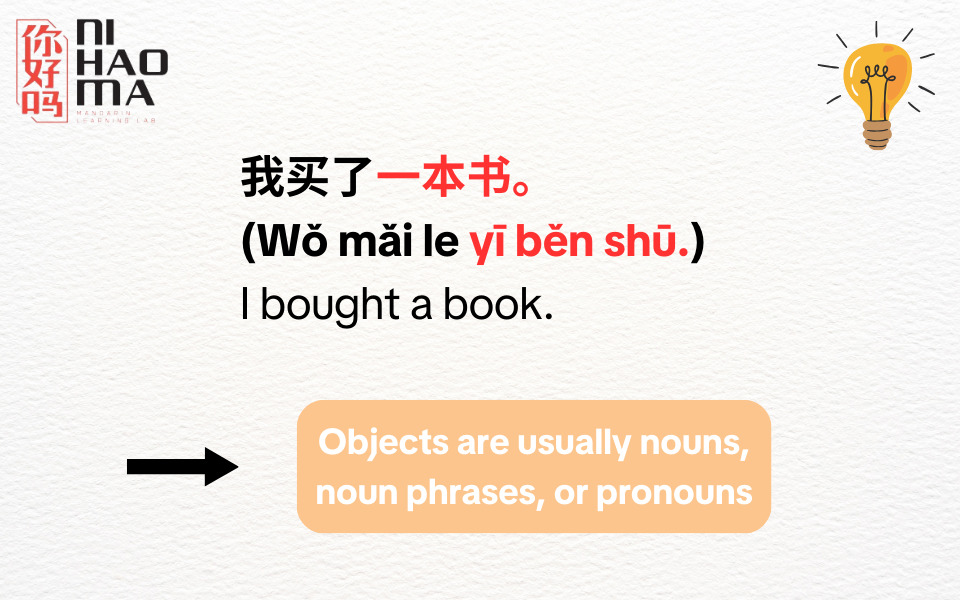
Complements, on the other hand, can take various forms — adjectives, verbs, phrases, or numerical expressions. Each type of complement adds different types of information to the verb.
Examples:
- 他跑得很快。 (Tā pǎo de hěn kuài.) – He runs very fast. (complement of manner – adjective)
- 他买了三本书。 (Tā mǎi le sān běn shū.) – He bought three books. (complement of quantity – numeral)
- 我想得很清楚。 (Wǒ xiǎng de hěn qīngchǔ.) – I thought it through very clearly. (complement of degree – adjective)
Role in the Sentence
Objects play a fundamental role and are essential in many transitive sentences (verb + object). Without an object, the sentence may become incomplete or ambiguous.
Example:
他买了。 (Tā mǎile.)
→ He bought… (bought what? The meaning is unclear.)
他买了一本书。 (Tā mǎile yī běn shū.)
→ He bought a book. (complete sentence)
In contrast, complements are optional elements that enrich and clarify the sentence. A sentence can often stand on its own without a complement.
Example:
- 他吃饭。(Tā chī fàn.) – He eats a meal. (complete sentence, no complement needed)
- 他吃得很快。(Tā chī de hěn kuài.) – He eats very quickly. (with a complement adding detail)
Summary
Objects in Mandarin are an essential component in Chinese sentence structures. Mastering different types of objects, understanding their positions, and learning how to use them correctly will help you express yourself in Mandarin more accurately and naturally. We hope that Ni Hao Ma has provided you with valuable insights into objects in Mandarin. Wishing you success in your Chinese learning journey!
